 |
In the past few weeks, every television news channel and, it appears, every news magazine too, has run stories and polls on who could, should, or would be India’s next prime minister. This is usually framed as a ‘Narendra Modi versus Rahul Gandhi’ contest, with most polls showing Modi as having a clear edge in the imagination of the middle-class, English-speaking voter.
These polls are influenced by the idea that Indian general elections are becoming presidential. Thus the focus on a single, hopefully redemptive, leader, rather than on parties, programmes, or coalitions. It is interesting to note that the admirers of both Rahul Gandhi and Narendra Modi have sought to compare their hero with the American president, Barack Obama. Rahul Gandhi’s Jaipur speech was seen by Congressmen as his ‘Obama’ moment. Modi’s supporters tell us that his message of economic optimism is ‘Obama-like’.
In neither case is the comparison really sustainable. Rahul Gandhi’s background of personal and social privilege is wholly unlike Obama’s, who had to work his way up from obscurity. Modi’s ideology and personal style are sectarian and divisive, and thus very dissimilar to the inclusive, accommodative, reconciling manner of the American president. Then, again, our cabinet system of governance is very different from the American model. It is more collaborative, and less reliant on experts and expertise. Finally, in spite of his manifest intelligence and superb oratorical skills, Obama has been a mediocre president. It is a sign both of our desperation and our sense of cultural inferiority that we would wish our leaders to be more like Barack Obama.
That said, this is not the first time a single leader has been projected as the face of his party in the run-up to an Indian general election. In 1952, 1957 and 1962, voters knew that to vote Congress meant that they were essentially voting for Jawaharlal Nehru. Nehru was his party’s principal calling card, selling point and campaigner. And its chief theoretician and ideologue too. In the run-up to the 1952 elections, Nehru travelled 25,000 miles — 18,000 by air, 5,200 by car, 1,600 by train, and even 90 by boat. He addressed no fewer than 300 election meetings. A party spokesman said of his leader’s peregrinations that he combined “the imperial campaigns of Samudragupta, Asoka and Akbar” with “the travels of Fahien and Hieun Tsang”.
In those early elections, the Opposition had no candidate remotely as charismatic or appealing as Nehru. In 1967, when the first general elections after Nehru’s death were held, the then insecure prime minister, Indira Gandhi, did not attract much enthusiasm among the voters. The Congress came back to power at the Centre, but with a greatly reduced majority. This encouraged Opposition parties to mount a more organized campaign the next time around. Thus, before the 1971 general elections, the Jana Sangh, the Swatantra Party, the Socialists, and several regional parties formed a ‘Grand Alliance’ to unseat the Congress. The slogan by which this alliance was constructed and by which it sought to project itself was “Indira hatao”.
Once more, as in Nehru’s day, there was a presidential element to a general election, with this significant difference — voters were asked not to elect an individual, but to defeat her. Indira Gandhi now smartly answered the Opposition slogan with one of her own: “Garibi hatao”. Whereas the main aim of her opponents, she insinuated, was merely to unseat her, she herself stood for a larger and grander political ideal —namely, the ending of mass poverty.
This depersonalizing of political debate stood Indira Gandhi well in the 1971 elections, when her party won a massive majority. But after the Emergency and its excesses, elections became individual-centric again. During the Emergency the ruling party claimed that “Indira is India, India is Indira”. The 1977 elections were thus fought on the issue of whether Indira Gandhi should continue in power. Unlike in 1971, this time the Opposition won, for in north India especially the Congress (and Indira Gandhi) had been discredited by the campaigns of forcible sterilization. However, the contradictions within this new ‘Grand Alliance’ were too hard to manage. The Janata Party broke up into its constituent elements. There was a mid-term election, in 1980, when Indira Gandhi now successfully presented herself as the voice of stability versus disorder.
Both in 1977 and in 1989 (when the election was fought and won on the question of whether Rajiv Gandhi was a suitable prime minister for India), it was only after the Congress was defeated that the combined Opposition began searching for a person to head the government. And who, before the 1996 elections, ever thought that H.D. Deve Gowda would be appointed prime minister? Even in the case of the Bharatiya Janata Party, in the years between the Ayodhya movement and their eventual capture of power at the Centre, Atal Bihari Vajpayee was never put forward as their sole contender for prime ministership. Both within and outside the party, L.K. Advani and M.M. Joshi were held to be as qualified as he.
By the latter half of the 1990s, however, it was clear that Vajpayee had become the BJP’s prime ministerial candidate. “Ab ki bari, Atal Bihari”, as the slogan went. In 1999 and 2004 he was explicitly put forward as the man who would run the government if his party won. Since the Congress president, Sonia Gandhi, did not have the experience or standing of Vajpayee, her party chose to campaign on the basis of a populist programme, captured in the slogan, “Kangrez ka haath aam admi ké saath”.
This historical survey tells us that although the frenzy and melodrama associated with television was absent in the past, from the time of the first general election itself, voters have been asked to choose as much on the basis of personalities as of programmes. The present debate, however, does mark a departure of sorts in that, for the first time in the history of the Indian elections, it asks us to choose between two individuals, each presumed to be the prime ministerial candidate of his party. In Nehru’s and Indira’s day, when the Congress was hegemonic in Indian politics, no single Opposition leader was presented as a viable prime ministerial alternative to them. When, in 1998, 1999, and 2004, Vajpayee was put forward as the BJP’s prime ministerial nominee, the Congress chose not to project a single person to oppose him.
The framing of the next general election as a ‘Modi vs Rahul’ contest is therefore quite novel. But how far, really, does this face-off promoted and promised by the media actually reflect hard political realities? In fact, Modi has not yet been chosen by his party as their official prime ministerial candidate. It is entirely possible that his name will be challenged by other BJP chief ministers who have won several elections themselves, as also by BJP leaders based in Delhi who think they are, in image or in reality, less sectarian and polarizing than Modi undoubtedly is.
Modi is by no means the only candidate from the BJP side, nor Rahul Gandhi from the Congress. There is also the possibility that neither the BJP nor the Congress shall win enough seats to form a government, in which case a V.P. Singh or Deve Gowda-like figure might run a coalition government for a year or two, before mid-term elections are called. Notably, Mayawati has already put forward her name as a candidate for the prime minister’s post.
And I think J. Jayalalithaa would fancy a crack at the job too. The Tamils have an ancient rivalry with the Kannadigas — having recently got a favourable verdict from the Supreme Court on the question of the Cauvery waters, they yet lag behind their neighbours in not having had a prime minister. Since plainly Modi and Rahul Gandhi do not exhaust the range of potential or likely candidates, perhaps the media should now divert itself — and us — with a ‘Mayawati vs Jayalalithaa’ debate instead.










